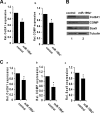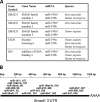miR-199a, a bone morphogenic protein 2-responsive MicroRNA, regulates chondrogenesis via direct targeting to Smad1
- PMID: 19251704
- PMCID: PMC2670138
- DOI: 10.1074/jbc.M807709200
miR-199a, a bone morphogenic protein 2-responsive MicroRNA, regulates chondrogenesis via direct targeting to Smad1
Abstract
MicroRNAs (miRNA) are short non-coding RNA molecules that regulate a variety of biological processes. The role of miRNAs in BMP2-mediated biological processes is of considerable interest. A comparative miRNA array led to the isolation of several BMP2-responsive miRNAs. Among them, miR-199a(*) is of particular interest, because it was reported to be specifically expressed in the skeletal system. Here we demonstrate that miR-199a(*) is an early responsive target of BMP2: its level was dramatically reduced at 5 h, quickly increased at 24 h and remained higher thereafter in the course of BMP2-triggered chondrogenesis of a micromass culture of pluripotent C3H10T1/2 stem cells. miR-199a(*) significantly inhibited early chondrogenesis, as revealed by the reduced expression of early marker genes for chondrogenesis such as cartilage oligomeric matrix protein (COMP), type II collagen, and Sox9, whereas anti-miR-199a(*) increased the expression of these chondrogenic marker genes. A computer-based prediction algorithm led to the identification of Smad1, a well established downstream molecule of BMP-2 signaling, as a putative target of miR-199a(*). The pattern of Smad1 mRNA expression exhibited the mirror opposite of miR-199a(*) expression following BMP-2 induction. Furthermore, miR-199a(*) demonstrated remarkable inhibition of both endogenous Smad1 as well as a reporter construct bearing the 3-untranslated region of Smad1 mRNA. In addition, mutation of miR-199a(*) binding sites in the 3'-untranslated region of Smad1 mRNA abolished miR-199a(*)-mediated repression of reporter gene activity. Mechanism studies revealed that miR-199a(*) inhibits Smad1/Smad4-mediated transactivation of target genes, and that overexpression of Smad1 completely corrects miR-199a(*)-mediated repression of early chondrogenesis. Taken together, miR-199a(*) is the first BMP2 responsive microRNA found to adversely regulate early chondrocyte differentiation via direct targeting of the Smad1 transcription factor.
Figures








Similar articles
-
[MicroRNA-199a-3p enhances expressions of fibrosis-associated genes through targeting Smad1 in mouse cardiac fibroblasts].Nan Fang Yi Ke Da Xue Xue Bao. 2018 Sep 30;38(10):1203-1208. doi: 10.3969/j.issn.1673-4254.2018.10.08. Nan Fang Yi Ke Da Xue Xue Bao. 2018. PMID: 30377137 Free PMC article. Chinese.
-
MicroRNA-145 regulates chondrogenic differentiation of mesenchymal stem cells by targeting Sox9.PLoS One. 2011;6(7):e21679. doi: 10.1371/journal.pone.0021679. Epub 2011 Jul 20. PLoS One. 2011. PMID: 21799743 Free PMC article.
-
Heparan sulfate proteoglycans including syndecan-3 modulate BMP activity during limb cartilage differentiation.Matrix Biol. 2006 Jan;25(1):27-39. doi: 10.1016/j.matbio.2005.07.008. Epub 2005 Oct 13. Matrix Biol. 2006. PMID: 16226436
-
Flexible and versatile as a chameleon-sophisticated functions of microRNA-199a.Int J Mol Sci. 2012;13(7):8449-8466. doi: 10.3390/ijms13078449. Epub 2012 Jul 9. Int J Mol Sci. 2012. PMID: 22942713 Free PMC article. Review.
-
Roles of microRNAs in prenatal chondrogenesis, postnatal chondrogenesis and cartilage-related diseases.J Cell Mol Med. 2013 Dec;17(12):1515-24. doi: 10.1111/jcmm.12161. Epub 2013 Oct 31. J Cell Mol Med. 2013. PMID: 24373548 Free PMC article. Review.
Cited by
-
The miRNA Regulation of Stem Cells.Wiley Interdiscip Rev Membr Transp Signal. 2012 Jan 1;1(1):83-95. doi: 10.1002/wdev.5. Epub 2011 Nov 17. Wiley Interdiscip Rev Membr Transp Signal. 2012. PMID: 23024929 Free PMC article.
-
A Survey of Strategies to Modulate the Bone Morphogenetic Protein Signaling Pathway: Current and Future Perspectives.Stem Cells Int. 2016;2016:7290686. doi: 10.1155/2016/7290686. Epub 2016 Jun 28. Stem Cells Int. 2016. PMID: 27433166 Free PMC article. Review.
-
The polysaccharides from Grifola frondosa attenuate CCl4-induced hepatic fibrosis in rats via the TGF-β/Smad signaling pathway.RSC Adv. 2019 Oct 21;9(58):33684-33692. doi: 10.1039/c9ra04679h. eCollection 2019 Oct 18. RSC Adv. 2019. PMID: 35528887 Free PMC article.
-
Regulation of the IGFBP-5 and MMP-13 genes by the microRNAs miR-140 and miR-27a in human osteoarthritic chondrocytes.BMC Musculoskelet Disord. 2009 Nov 30;10:148. doi: 10.1186/1471-2474-10-148. BMC Musculoskelet Disord. 2009. PMID: 19948051 Free PMC article.
-
MicroRNAs in cartilage development, homeostasis, and disease.Curr Osteoporos Rep. 2014 Dec;12(4):410-9. doi: 10.1007/s11914-014-0229-9. Curr Osteoporos Rep. 2014. PMID: 25091054 Free PMC article. Review.
References
-
- Lewis, B. P., Burge, C. B., and Bartel, D. P. (2005) Cell 120, 15-20 - PubMed
-
- Chan, S. P., and Slack, F. J. (2006) RNA Biol. 3, 97-100 - PubMed
-
- Chen, C. Z., Li, L., Lodish, H. F., and Bartel, D. P. (2004) Science 303, 83-86 - PubMed
-
- Esau, C., Kang, X., Peralta, E., Hanson, E., Marcusson, E. G., Ravichandran, L. V., Sun, Y., Koo, S., Perera, R. J., Jain, R., Dean, N. M., Freier, S. M., Bennett, C. F., Lollo, B., and Griffey, R. (2004) J. Biol. Chem. 279, 52361-52365 - PubMed
Publication types
MeSH terms
Substances
Grants and funding
LinkOut - more resources
Full Text Sources
Other Literature Sources
Molecular Biology Databases
Research Materials
Miscellaneous

